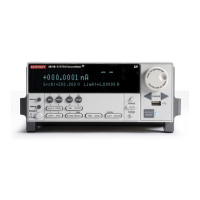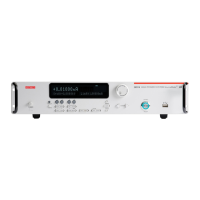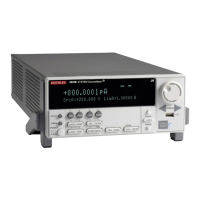12-4 Return to Section Topics 2600S-901-01 Rev. C / January 2008
Section 12: Instrument Control Library Series 2600 System SourceMeter® Instruments Reference Manual
Reading an attribute
Reading an attribute is accomplished by passing it to a function call as a parameter or by
assigning it to another variable.
Parameter passing example – The following command reads the filter type for SMU A by passing
the attribute to the
print function, which outputs a value:
print(smua.measure.filter.type)
Output: 0.000000e+00
The above output indicates that the moving average filter is selected.
Variable assignment example – The following command reads the filter type by assigning the
attribute to a variable named
filtertype:
filtertype = smua.measure.filter.type
Syntax rules
• Commands for functions and attributes are case sensitive. As a general rule, all function
and attribute names must be in lower case, while parameters use a combination of lower
and upper case characters. Upper case characters are required for attribute constants.
Example:
smua.source.func = smua.OUTPUT_DCVOLTS
In the above command to select the volts source function, OUTPUT_DCVOLTS is the attribute
constant.
• Whitespace in a function is not required. The function to set digital I/O line 3 low can be sent
with or without whitespaces as follows:
digio.writebit(3,0) -- Whitespaces NOT used in string.
digio.writebit (3, 0) -- Whitespaces used in string.
• Some commands require multiple parameters. Multiple parameters must be separated by
commas (,), as shown above for the
digio.writebit function.
TSP-Link nodes
Each instrument or enclosure attached to the TSP-Link bus must be uniquely identified. This
identification is called a TSP-Link node number, and the enclosures are called nodes. Each node
must be assigned a unique node number.
From a Test script program (TSP) point of view, nodes look like tables. There is one global table
named
node that contains all the actual nodes that are themselves tables. An individual node is
accessed as
node[N] where N is the node number assigned to the node. Each node has certain
attributes that can be accessed as elements of its associated table. These are listed as follows:
id The node number assigned to the node.
model The product model number string of the node.
revision The product revision string of the node.
serialno The product serial number string of the node.
There is also an entry for each logical instrument on the node (see “Logical instruments”).
It is not necessary to know the node number of the node running a script. The variable localnode
is an alias for the node entry the script is running on. For example, if a script is running on node 5,
the global variable
localnode will be an alias for node[5].

